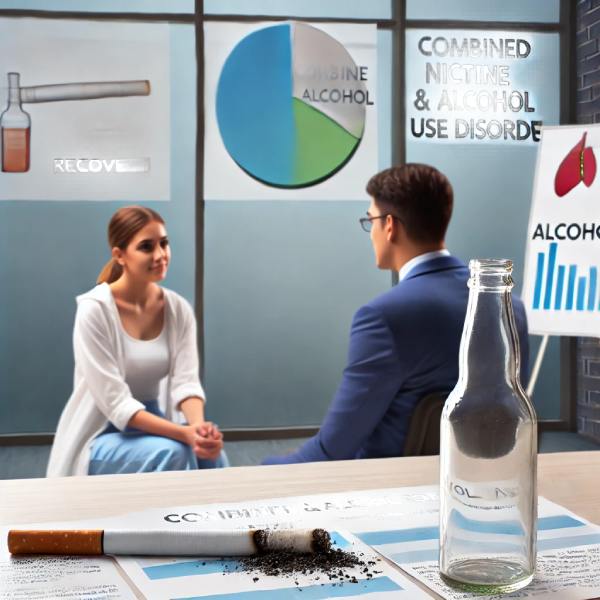Most adults who smoke also drink, and many drinkers light up when they have a beverage in hand. That overlap is more than a casual habit: when nicotine and alcohol reinforce each other, the brain rewires itself to crave the pair, not just one or the other. Combined Nicotine and Alcohol Use Disorder (CNAUD) describes a pattern of compulsive, harmful use of both substances that feed off each other’s cues, heightening addiction severity and complicating recovery. Understanding CNAUD—how it develops, how to spot it, and how to heal—can prevent serious disease and save lives.
Table of Contents
- Trends and Widespread Patterns
- Underlying Drivers and Vulnerabilities
- Key Indicators, Manifestations, and Clinical Evaluation
- Physical, Mental, and Social Repercussions
- Intervention Strategies and Long-Term Renewal
- Answers to Common Questions
Trends and Widespread Patterns
Decades of epidemiological data show an unbreakable bond between cigarettes and booze. Roughly 80 % of people with alcohol use disorder (AUD) smoke, and smokers are four times likelier than non-smokers to drink at hazardous levels. Dual use starts early: high-school surveys reveal that students who binge-drink are nine times likelier to vape nicotine daily. College bar culture continues the pairing, while service-industry and military settings reinforce it in adulthood.
Why do the substances cluster? Alcohol temporarily eases the harsh throat hit of smoke, while nicotine sharpens alertness — a convenient counterbalance to alcohol’s sedation. Both stimulate the mesolimbic dopamine pathway, so the brain starts interpreting “cigarette plus drink” as a single super-reward. Cue conditioning then cements the loop: the smell of a pub patio triggers a smoke craving; a puff of a vape triggers a beer craving. Because each drug primes receptors for the other, quit attempts for one often fail unless both are treated together.
Worldwide patterns stress urgency. Although cigarette sales decline, vaping rises, and “light” drink trends disguise harmful intake. Meanwhile, flavored e-liquids pair seamlessly with craft cocktails, making co-use feel hip rather than risky. Public-health surveys fear a stall — or reversal — in progress on either addiction if dual-use strategies lag.
Underlying Drivers and Vulnerabilities
Nicotine and alcohol interact on molecular, genetic, psychological, and social levels, weaving a complex net that traps millions.
Neurobiological Crosstalk
- Shared reward circuitry Both agonize nicotinic acetylcholine receptors (nAChRs) on dopamine neurons, amplifying dopamine release into the nucleus accumbens. When taken together, dopamine spikes last longer and feel more intense than either substance alone.
- Cross-sensitization Animal models show that prior nicotine exposure heightens later alcohol self-administration; the reverse also holds true. Each substance “primes” the brain for the other, escalating consumption over time.
- Stress-axis activation Alcohol triggers cortisol, while nicotine dampens stress momentarily but raises baseline cortisol with chronic use. The up-down tug fatigues homeostasis, perpetuating the cycle.
Genetic Susceptibility
Variants in the CHRNA5/CHRNA3/CHRNB4 gene cluster raise nicotine dependence risk and, in many carriers, parallel a higher AUD risk. Polymorphisms in ADH1B and ALDH2 alter alcohol metabolism; when drinking feels milder due to rapid breakdown of acetaldehyde, users may drink—and smoke—more. Genetics account for roughly 40 % of co-use liability, but environment modulates expression.
Developmental and Psychological Triggers
- Adolescence An immature prefrontal cortex craves novelty. Trying one substance lowers perceived risk of the other (“gateway effect”).
- Self-medication Individuals with depression or social anxiety often use nicotine for focus and alcohol for disinhibition, creating a synergistic coping routine.
- ADHD Impulsivity and dopamine dysregulation make rapid-acting nicotine and relaxing alcohol attractive.
- Trauma and PTSD Both substances numb hyperarousal, but long-term exacerbate it, keeping users stuck.
Social and Cultural Catalysts
- “Smoke breaks” outside bars foster peer bonding; refusal feels isolating.
- Advertising pairs rugged images (cigars, whiskey) or glamorous vibes (slim vapes, rosé) to sell lifestyles.
- Hospitality, trucking, and shift-work sectors normalize drinking-smoking rituals after long hours.
- Family modeling: children raised around both substances internalize the pairing as adulthood’s default.
Recognizing these multi-layer forces helps tailor prevention and treatment to an individual’s risk profile.
Key Indicators, Manifestations, and Clinical Evaluation
CNAUD symptoms often masquerade as “just social habits,” so clinicians — and users themselves — must look beyond quantity alone.
Behavioral Clues
- Drinking triggers smoking lapses, even after long nicotine quit periods.
- Attempts to reduce one substance increase use of the other (“seesaw effect”).
- Social plans revolve around settings that permit both: patios, casinos, tailgate parties.
- Morning nicotine “eye-openers” balance hangovers; evening drinks calm nicotine jitters.
Physical Signs
| Nicotine dominant | Alcohol dominant | Combined red flags |
|---|---|---|
| Chronic cough, stained fingers, mouth ulcers | Facial flushing, gastritis, hypertension | Persistent hoarseness, esophageal irritation, irregular heartbeat |
| Elevated resting heart rate | Elevated liver enzymes, triglycerides | Synergistic cardiovascular strain, atrial fibrillation episodes |
| Nighttime awakenings to vape | Night sweats, insomnia | Severe sleep fragmentation and daytime fatigue |
Psychological Markers
- Heightened anxiety between cigarettes when alcohol levels fall.
- Irritability, restlessness, and concentration dips if both substances aren’t simultaneously available.
- Memory gaps: blackouts compound with nicotine-induced vasoconstriction, impairing oxygen delivery.
Diagnostic Approach
The DSM-5 provides separate criteria for Tobacco Use Disorder and Alcohol Use Disorder. To capture their merger, clinicians should:
- Administer dual screening tools e.g., Fagerström Test for Nicotine Dependence plus AUDIT-C on the same visit.
- Map triggers in pairings Ask: “When do you always do both?” Patterns reveal conditioned cues vital for treatment planning.
- Assess withdrawal interactions Nicotine irritability may intensify alcohol craving; alcohol tremor may drive chain-vaping.
- Run labs CBC for macrocytosis, CMP for liver function, cotinine levels for accurate nicotine intake, and breathalyzer or phosphatidylethanol (PEth) for alcohol use.
Physical, Mental, and Social Repercussions
Individually, nicotine and alcohol harm nearly every organ. Together, they magnify each other’s toxicity and accelerate disease timelines.
Cancer Synergy
Smoking alone raises oral-cancer risk sixfold; heavy drinking triples it. Co-use multiplies the risk nearly forty-fold due to acetaldehyde (from alcohol metabolism) making mucosa more susceptible to tobacco carcinogens. Esophageal, laryngeal, and pancreatic cancers show similar synergy.
Cardiovascular Fallout
- Hypertension escalation Nicotine spikes heart rate; alcohol raises blood pressure. Chronic dual use doubles stroke risk compared to alcohol alone.
- Atherosclerosis Oxidative stress from smoking promotes plaque; ethanol raises LDL. Their combination accelerates arterial aging.
- Arrhythmias Both prolong QT interval; combined binge episodes precipitate ventricular tachycardia.
Liver and Metabolic Damage
Smoking worsens insulin resistance; alcohol promotes fatty liver. Together they push faster toward non-alcoholic steatohepatitis (NASH) and cirrhosis. Dual users develop type 2 diabetes more frequently than single-substance peers.
Neurocognitive Decline
Longitudinal studies show steeper cognitive-function drop — memory, executive skills, processing speed — among dual users by middle age. MRI scans reveal greater cortical thinning in frontal and temporal lobes, likely from compounded vascular injury and neurotoxicity.
Mental-Health Burden
Co-use correlates with higher rates of major depression, suicidal ideation, and panic disorder. Some evidence suggests nicotine dulls prefrontal control circuits, while alcohol weakens limbic emotion regulation, creating a loop of dysphoria relieved only briefly by more intake.
Social Consequences
- Workplace impairment Smokers who drink heavily log more sick days, micro-breaks, and lower productivity.
- Relationship strain Partners frequently cite smell, secondhand smoke, and drinking-related aggression as sources of conflict.
- Financial drain Dual habits can cost thousands annually, diverting funds from savings, nutrition, or childcare.
Intervention Strategies and Long-Term Renewal
Treating CNAUD effectively means tackling both substances together — sequential or isolated approaches yield poorer outcomes.
1. Preparing for Change
- Motivational Interviewing Explore ambivalence: some worry quitting smoking will intensify alcohol urges and vice versa. Evoke personal reasons (e.g., running a marathon, being present for grandchildren) to build intrinsic drive.
- Cue Mapping Create a trigger diary: times, places, emotional states where the pair reign. Awareness guides tailored coping plans.
2. Pharmacotherapy
| Goal | First-line options | How they help |
|---|---|---|
| Dual craving reduction | Varenicline plus naltrexone | Varenicline blunts nicotine reward; naltrexone curbs alcohol buzz and cuts relapse by 17 %. Together, they halve cigarette and heavy-drinking days in clinical trials. |
| Smoking cessation when liver disease present | Nicotine Replacement Therapy (NRT) patches + gum/lozenges | Provides steady nicotine without tar; safe in early cirrhosis when varenicline metabolism may slow. |
| Alcohol abstinence when severe nicotine dependence persists | Acamprosate | Stabilizes glutamate; does not interact significantly with NRT. |
| Harm reduction step | Bupropion SR | Alleviates depression, reduces cigarette craving, and modestly lowers alcohol intake in some. |
Careful monitoring for liver enzymes and blood pressure is necessary, as medications plus withdrawal shifts can stress physiology.
3. Behavioral Therapies
- Integrated CBT Teaches skills to dismantle joint triggers: replacing “beer-and-smoke after work” with sparkling water and a stress walk; rehearsing refusal lines.
- Contingency Management Provide vouchers or digital badges for negative breath CO and zero-alcohol biomarkers.
- Mindfulness-Based Relapse Prevention Interrupt urge waves with body scans and urge surfing; studies show 30 % increased abstinence at 12 months.
- Digital Apps Combined-use modules send “high-risk time” alerts (e.g., Friday 5 p.m.) and offer craving distraction tasks.
4. Supportive and Environmental Strategies
- Sober-friendly social networks Encourage joining smoke-free fitness clubs, volunteer groups, or hobby classes to fill weekend slots.
- Household rules Implement no-alcohol, no-smoking zones at home; remove paraphernalia.
- Nutrition and Exercise High-protein breakfasts blunt nicotine craving; aerobic workouts raise dopamine and endorphins naturally.
5. Managing Withdrawal and Early Recovery
Nicotine withdrawal peaks within a week; alcohol detox may need medical supervision for seizures or delirium tremens (DTs). Coordinated care can:
- Use benzodiazepines or gabapentin for alcohol detox while providing NRT to pre-empt smoke cravings.
- Check vitals twice daily; hydrate aggressively; reinforce sleep hygiene with melatonin.
- Introduce light exercise (walking, stretching) by day 4 to reduce irritability.
6. Long-Term Maintenance
- Booster sessions Monthly check-ins for six months reduce relapse by keeping motivation fresh.
- Peer groups Nicotine-Anonymous and Alcoholics Anonymous often overlap times; encourage attending both or dual-focus meetings.
- Lifestyle identity shift Help clients say “I’m a runner” or “I’m a photographer” instead of “I’m trying to quit.” Building new identity staves off nostalgic triggers.
Recovery is nonlinear. Slip-ups offer data: What cue did I miss? What skill can I sharpen? Celebrate each tobacco-free, alcohol-free day; evidence shows consecutive weeks double the odds of lifetime abstinence.
Answers to Common Questions
Why do cigarettes taste better when I’m drinking?
Alcohol enhances sweet and bitter perception, muting tobacco’s harshness and boosting dopamine release, so the combination feels more rewarding than either substance solo.
Can vaping while drinking really be that bad?
Yes. E-liquids still deliver nicotine which pairs with alcohol to strengthen addiction pathways, and flavored vapors can mask early signs of alcohol intoxication, leading to higher consumption.
Should I quit smoking before tackling my drinking problem?
Evidence shows quitting both together improves success rates because triggers overlap. However, if severe alcohol withdrawal is likely, detox first under medical care, then address nicotine immediately after stabilization.
Do non-alcoholic beers trigger cigarette cravings?
They can. The taste and setting recreate drinking cues linked in your brain to smoking. Using alternative beverages, like flavored sparkling water, may avoid that conditioned response.
How long until my risk of mouth cancer drops after quitting both?
Risk begins falling within a year and continues for 10–15 years before nearing that of never-users. Dual abstinence accelerates the decline compared to quitting only one substance.
Will weight gain sabotage my recovery?
Some gain modest weight after quitting nicotine; planning balanced meals and regular exercise can limit it. Health benefits of stopping far outweigh temporary changes in body weight.
Disclaimer
This article is for educational purposes only and is not a substitute for professional medical advice, diagnosis, or treatment. Always seek a qualified healthcare provider with questions about nicotine, alcohol, or any other substance use.
If you found this guide helpful, please share it on Facebook, X (formerly Twitter), or any platform you prefer—and follow us for more evidence-based, reader-friendly health content. Your support helps us keep producing quality articles. Thank you!











